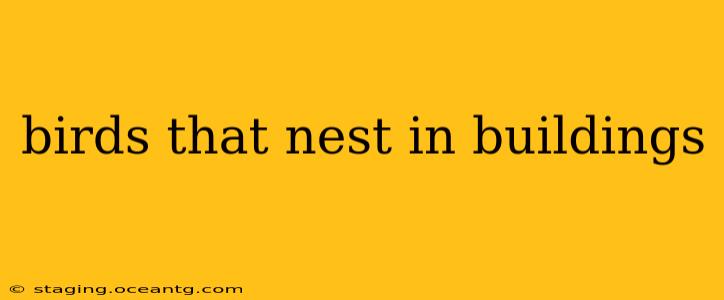Many bird species have adapted to urban environments, finding shelter and nesting sites in and around human-made structures. This has led to fascinating interactions between humans and wildlife, sometimes harmonious, sometimes challenging. This guide explores the common birds that nest in buildings, their nesting habits, and how to manage potential conflicts.
What attracts birds to nest in buildings?
Several factors attract birds to build nests in buildings. Availability of nesting sites is a primary factor. Buildings offer sheltered cavities, ledges, and crevices unavailable in their natural habitats, especially in urban areas with limited trees and suitable natural nesting sites. The presence of food sources nearby, such as insects attracted to lights or readily available seeds and scraps, also plays a crucial role. Finally, the relative safety from some predators that buildings offer can make them attractive nesting locations.
What types of birds commonly nest in buildings?
Numerous bird species can be found nesting in buildings, depending on the region and building type. Some of the most common include:
-
House Sparrows: These highly adaptable birds are prolific nesters in buildings, often utilizing eaves, vents, and other cavities. Their nests are bulky and untidy, sometimes causing minor structural issues.
-
Rock Pigeons: Known for their ability to thrive in urban environments, rock pigeons frequently nest on ledges, windowsills, and in building crevices. Their droppings can be a significant nuisance.
-
House Wrens: These small, active birds are known to nest in a variety of locations, including birdhouses, wall crevices, and even drainpipes. Their nests are compact and well-constructed.
-
Swallows (Barn and Cliff): These birds often nest under eaves, in attics, and other sheltered areas. Their mud nests are distinctive and are usually found in colonies.
-
Starlings: Starlings are another highly adaptable species that readily nest in buildings, often occupying cavities in walls and attics. They can be quite noisy and produce large quantities of droppings.
What are the problems associated with birds nesting in buildings?
While seeing birds nesting in buildings can be enjoyable, there are potential drawbacks:
-
Droppings: Bird droppings are unsightly and can damage building materials, especially if accumulated over time. They can also carry diseases.
-
Nests: Large nests can block vents, gutters, and other critical building components, potentially causing damage or safety hazards.
-
Noise: Some species, particularly starlings, can be quite noisy, particularly during breeding season.
-
Damage: Birds may peck at window seals, siding, or other building materials during nest construction or territorial defense.
-
Infestations: Nests can attract other pests, such as insects or rodents.
How can I deter birds from nesting in my building?
Deterrent methods vary in effectiveness and should be used humanely. It's crucial to remember that many birds are protected by law, and harming or destroying nests is often illegal. Effective deterrents include:
-
Physical barriers: Netting, spikes, or wires can prevent birds from accessing nesting sites.
-
Visual deterrents: Shiny objects, reflective tape, or plastic owls can discourage birds from landing.
-
Auditory deterrents: Ultrasonic devices emit high-frequency sounds that can be unpleasant to birds but are generally inaudible to humans.
-
Bird netting: Using appropriate bird netting over vulnerable areas can prevent birds from accessing these spots.
-
Removal of nesting materials: Regularly removing any nesting materials from potential nesting sites can discourage further attempts.
What should I do if I find a bird's nest in my building?
If you discover a bird's nest in your building, it's crucial to act carefully and responsibly. Avoid disturbing the nest, especially if eggs or chicks are present. Contact your local wildlife rehabilitation center or animal control for guidance. They can advise you on the best course of action, considering the species of bird and local regulations. Many jurisdictions have laws protecting birds and their nests.
How can I attract birds to nest in birdhouses instead of my building?
Providing suitable birdhouses can encourage birds to nest in designated areas away from the main building structure. Ensure the birdhouses are properly placed, well-ventilated, and appropriately sized for the targeted bird species. Consider placing them in a location that provides protection from predators and harsh weather. Regular cleaning and maintenance of the birdhouses are also important.
By understanding the birds that nest in buildings, their habits, and the potential challenges they present, you can effectively manage your property while ensuring the well-being of the birds. Remember to always prioritize humane and legal methods for bird control and encourage coexistence whenever possible.
